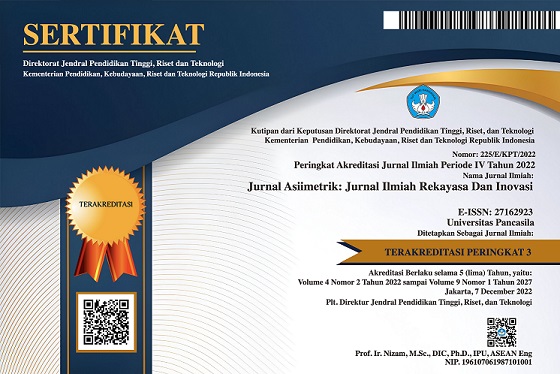Numerical Analysis of Gurney Flap Impact on NACA 4415 Airfoil Aerodynamics Performance
DOI:
https://doi.org/10.35814/asiimetrik.v6i1.5722Keywords:
airfoil, computation, gurney flap, flap size, aerodynamics performanceAbstract
Improving airfoil aerodynamic performance is an essential aspect of aerodynamic technology. The use of passive flow control is one way to enhance the aerodynamic performance of the airfoil. The influence of using gurney flaps as passive flow control was explored through the CFD approach employing the RANS control equations with the k-epsilon turbulence model. The airfoil model utilized in this investigation was the NACA 4415 operating at a Reynolds number of 1×106. This study explored three different variations of flap height, namely 0.5%, 1%, and 2% of chord length. The outcomes showed that adding gurney flaps showed quite positive results in increasing the lift and drag performance of NACA 4415. An airfoil with a 0.5%c height flap has an average percentage increase in Cl of 12%, followed by a height flap of 1%c, which is 23%, and a percentage Cl of 37% for a height flap of 2%c. Meanwhile, each variation in height flap affected the increase in Cd. A height flap of 0.5%c increased Cd with an average percentage of 2%, while a height flap of 1%c increased the percentage of Cd by 4% and 6% for a height flap of 2%c. Moreover, visualization of fluid flow with pressure and velocity contours given at AoA 12º to determine the effect on the increase in Cland Cd in NACA 4415.
Downloads
References
Abbas, A., de Vicente, J. and Valero, E. (2013) ‘Aerodynamic technologies to improve aircraft performance’, Aerospace Science and Technology, 28(1), pp. 100–132.
Abbott, I.H., Von Doenhoff, A.E. and Stivers, L. (1945) ‘Summary of Airfoil Data’. Available at: https://ntrs.nasa.gov/citations/19930090976 (Accessed: 30 January 2023).
Aftab, S.M.A., Razak, N.A., et al. (2016) ‘Mimicking the humpback whale: An aerodynamic perspective’, Progress in Aerospace Sciences, 84, pp. 48–69.
Aftab, S.M.A., Rafie, A.S.M., et al. (2016) ‘Turbulence Model Selection for Low Reynolds Number Flows’, PLOS ONE, 11(4), p. e0153755.
Alom, N., Borah, B. and Saha, U.K. (2018) ‘An insight into the drag and lift characteristics of modified Bach and Benesh profiles of Savonius rotor’, Energy Procedia, 144, pp. 50–56.
Çıtak, C. (2015) Wave drag optimization of high speed aircraft. Master Thesis. Middle East Technical University.
Collis, S.S. et al. (2004) ‘Issues in active flow control: theory, control, simulation, and experiment’, Progress in Aerospace Sciences, 40(4), pp. 237–289.
Durrani, N. et al. (2011) ‘A Detailed Aerodynamic Design and Analysis of a 2-D Vertical Axis Wind Turbine Using Sliding Mesh in CFD’, in 49th AIAA Aerospace Sciences Meeting including the New Horizons Forum and Aerospace Exposition. American Institute of Aeronautics and Astronautics (Aerospace Sciences Meetings), pp. 1–16.
Giguere, P., Lemay, J. and Dumas, G. (1995) ‘Gurney flap effects and scaling for low-speed airfoils’, in 13th Applied Aerodynamics Conference. American Institute of Aeronautics and Astronautics, pp. 966–974.
Graham, M., Muradian, A. and Traub, L.W. (2018) ‘Experimental Study on the Effect of Gurney Flap Thickness on Airfoil Performance’, Journal of Aircraft, 55(2), pp. 897–904.
Hao, L. et al. (2021) ‘Numerical Simulation of Flow over Bionic Airfoil’, International Journal of Aerospace Engineering, 2021, p. e5556463.
Julian, J. et al. (2016) ‘The Effect of Plasma Actuator Placement on Drag Coefficient Reduction of Ahmed Body as an Aerodynamic Model’, International Journal of Technology, 7(2), pp. 306–313.
Julian, J., Anggara, R.A. and Wahyuni, F. (2023) ‘Influence of Slat Size Variation as Passive Flow Control Instruments on NACA 4415 Airfoil Toward Aerodynamic Performance’, International Journal of Marine Engineering Innovation and Research, 8(2), pp. 367–375.
Julian, J., Iskandar, W. and Wahyuni, F. (2022) ‘Aerodynamics Improvement of NACA 0015 by Using Co-Flow Jet’, International Journal of Marine Engineering Innovation and Research, 7(4).
Julian, James, Iskandar, W. and Wahyuni, F. (2023) ‘Analysis Of Aerodynamic Performance Of Erosion Airfoil With Reynolds Number Variations’, Jurnal Ilmiah Teknologi dan Rekayasa, 28(2), pp. 102–116.
Julian, J., Iskandar, W. and Wahyuni, F. (2023) ‘Effect of Mesh Shape and Turbulence Model on Aerodynamic Performance at NACA 4415’, Journal of Applied Fluid Mechanics, 16(12), pp. 2504–2517.
Lew†, A.J., Buscalgia, G.C. and Carrica, P.M. (2001) ‘A Note on the Numerical Treatment of the k-epsilon Turbulence Model*’, International Journal of Computational Fluid Dynamics, 14(3), pp. 201–209.
Li, Y., Wang, J. and Zhang, P. (2003) ‘Influences of Mounting Angles and Locations on the Effects of Gurney Flaps’, Journal of Aircraft, 40(3), pp. 494–498.
Liebeck, R.H. (1978) ‘Design of Subsonic Airfoils for High Lift’, Journal of Aircraft, 15(9), pp. 547–561.
Neuhart, D.H. and Pendergraft, O.C. (1988) A water tunnel study of Gurney flaps. L–16467. Available at: https://ntrs.nasa.gov/citations/19890004024 (Accessed: 20 January 2022).
Rosti, M.E., Omidyeganeh, M. and Pinelli, A. (2018) ‘Numerical Simulation of a Passive Control of the Flow Around an Aerofoil Using a Flexible, Self Adaptive Flaplet’, Flow, Turbulence and Combustion, 100(4), pp. 1111–1143.
Saha, S.K., Alam, Md.M. and Hasan, A.B.M.T. (2018) ‘Numerical investigation of gurney flap aerodynamics over a NACA 2412 airfoil’, AIP Conference Proceedings, 1980(1), p. 040020.
Shan, H. et al. (2008) ‘Numerical study of passive and active flow separation control over a NACA0012 airfoil’, Computers & Fluids, 37(8), pp. 975–992.
Siddiqi, Z. and Lee, J. (2019) ‘A computational fluid dynamics investigation of subsonic wing designs for unmanned aerial vehicle application’, Proceedings of the Institution of Mechanical Engineers, Part G: Journal of Aerospace Engineering, 233(15), pp. 5543–5552.
Tamura, T. and Miyagi, T. (1999) ‘The effect of turbulence on aerodynamic forces on a square cylinder with various corner shapes’, Journal of Wind Engineering and Industrial Aerodynamics, 83(1), pp. 135–145.
Xiao, H. et al. (2016) ‘Quantifying and reducing model-form uncertainties in Reynolds-averaged Navier–Stokes simulations: A data-driven, physics-informed Bayesian approach’, Journal of Computational Physics, 324, pp. 115–136.
Yang, J. et al. (2020) ‘Experimental Study on Aerodynamic Characteristics of a Gurney Flap on a Wind Turbine Airfoil under High Turbulent Flow Condition’, Applied Sciences, 10(20), p. 7258.
Zhang, P.F., Liu, A.B. and Wang, J.J. (2009) ‘Aerodynamic Modification of NACA 0012 Airfoil by Trailing-Edge Plasma Gurney Flap’, AIAA Journal, 47(10), pp. 2467–2474.





























